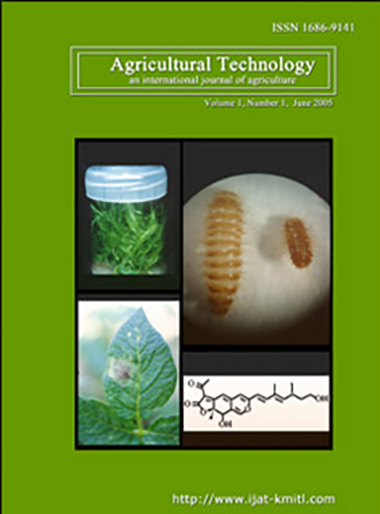Anti-feedant and growth inhibitory effects of seed extracts of custard apple, Annona squamosa against Khapra Beetle, Trogoderma granarium
Main Article Content
Abstract
The anti-feedant and growth inhibitory effects of seed extracts of custard apple in hexane, ethyl acetate and methanol were tested against neonate and 7 days old larvae of the Khapra beetle, Trogoderma granarium, using a feeding bioassay. The LC50 values for hexane, ethyl acetate and methanol extracts were 1195.41, 305.36 and 1446.32 ppm for neonate larvae; 5805, 1300 and 5815 ppm for 7 days old larvae, respectively. Drastic reduction in larval weight was observed in all extracts as compared with the control (acetone). The weight of five larvae in the control (acetone) was 6.03 mg after 15 days of release of neonate larvae. In case of Annona squamosa seed hexane extract the larval weight near LC50 (1250 ppm) was 0.65 mg, whereas in ethyl acetate (250 ppm) and methanol extract (1500 ppm) it was 0.91 and 0.90 mg, respectively. Ethyl acetate extract at 1250 ppm showed maximum anti-feedant activity of 44.50 and 59.50% after 10 and 15 days of release, respectively, whereas 35.68 and 53.45 % for hexane extract and 26.07 and 38.65% for methanol extract was observed at same concentration after 10 and 15 days of release, respectively. Annona squamosa seed ethyl acetate extract produced 55.73% anti-feedant activity for 7 days old larvae while hexane and methanol extracts produced 50 and 25.04%, respectively. The present study conclusively showed that A. squamosa seed ethyl acetate extract was superior to hexane and methanol extracts and first such study against Khapra beetle.
Article Details

This work is licensed under a Creative Commons Attribution-NonCommercial-NoDerivatives 4.0 International License.
References
Brady, N.C., Khush, G.S. and Heinrichs, E.A. (1978). Visit of the IRRI team to the Socialist Republic of Vietnam April 13-May 19. IRRI Annual Report: 49.
Deshmukh, P.B., Chavan, S.R. and Renapurkar, D.M. (1982). A study of insecticidal activity of twenty indigenous plants. Pesticides 16: 7-12.
Fishwick, F.B. (1988). Pesticide residues in grain arising from post harvest treatment. Aspects of Applied Biology 17: 37-46.
Hemlata, M.K., Prashant, S.M., Sangeeta, V.G.S.S., Shipra, R.J., Shripad, M.U. and Meheshwari, V.L. (2001). Antimicrobial and pesticidal activity of partially purified flavonoids of Annona squamosa. Pest Management Science 58: 33-37.
Huang, Y., Tan, J.M.W.L., Kini, R.M. and Ho, S.H. (1998). Toxic and antifeedant action of nutmeg oil against Tribolium castaneum (Herbst) and Sitophilus zeamais Motsch. Journal of Stored Products Research 33: 289-298.
Jacobson, M. (1958). Insecticides from Plants, a Review of Literature, 1941-1953. United states Department of Agriculture, Agricultural Research Service, Agricultural Handbook, No. 154.
Jacobson, M. (1975). Insecticides from Plants, a Review of Literature, 1954-1971. United states Department of Agriculture, Agricultural Research Service, Agricultural Handbook, No. 461.
Jacobson, M. (1983). Phytochemicals for the control of stored product insects. In: Proceedings of the Third International Working Conference on Stored Product Entomology. Kansas State University, Manhattan, Kansas: 182-195.
Jacobson, M. (1989). Botanical Pesticides: Past, present and future. In: Insecticides of Plant Origin (eds. J.T. Arnason, B.J. Philogene and P. Morland), American Chemical Society, Washington DC: 1-10.
Kawazu, K., Alcantara, P.J. and Kobayashi, A. (1989). Isolation and structure of Neoannonin, a novel insecticidal compound from the seeds of Annona squamosa. Agricultural Biological Chemistry 53: 2719-2722.
Luco, J.M., Sosa, M.C., Cesco, J.C., Ton, C.E. and Giordano, O.S. (1994). Molecular connectivity and hydrophobicity in the study of antifeedant activity of clerodane diterpenoids. Pesticide Science, 41: 1-6.
Mohan, S. (2003). Issues in the management of insects of food grain. Proceedings of the National Symposium on frontier areas of Entomological Research, IARI, New Delhi,423.
Nakakita, H. (1998). Stored rice and stored product insects. In: Rice Inspection Technology Manual. A.C.E. Corporation, Tokyo, Japan: 49-65.
Pant, N.C. (1956). Nutritional studies on Trogoderma granarium Everts, basic food and vitamin requirements. Indian Journal of Entomology 18: 259-266.
Pruthi, H.S. and Singh, M. (1950). Pests of Stored Grain and their Control. Government of India Press, Calcutta, India.
Qudri, S.S.H. and Rao, B.B. (1977). Effect of combining some indigenous plant seed extracts against household insects. Pesticides 11: 21-23.
Santosh Babu, P.B., Rao, J.M., Beena, J. and Sumathykutty (1996). Evaluation of some plant extracts as feeding deterrents against adult Longitarsus nigripennis Mots (Coleoptera: Chrysomelidae). Entomon 21: 291-294.
Saxena, R.C., Harshan, V., Saxena, A., Sukumaran, P., Sharma, M.C. and Kumar, M.L. (1993). Larvicidal and chemosterilant activity of Annona squamosa alkaloids against Anopheles stephensi. Journal of the American Mosquito Control Association 9: 84-87.
Vyas, B.N., Ganesan, S., Raman, K., Godrej, N.B. and Mistry, K.B. (1999). Effects of three plant extracts and achook: a commercial neem formulation on growth and development of three noctuid pests. In: Azadirachta indica A. Juss. (eds. R.P. Singh and R.C. Saxena). Science Publishers, Inc. Enfield, USA: 103-109.
Wright, C.G., Leidy, R.B. and Dupree, Jr. H. E. (1993). Cypermethrin in the ambient air and on surfaces of room treated for cockroaches. Bulletin of Environmental Contamination and Toxicology 51: 356-360.


